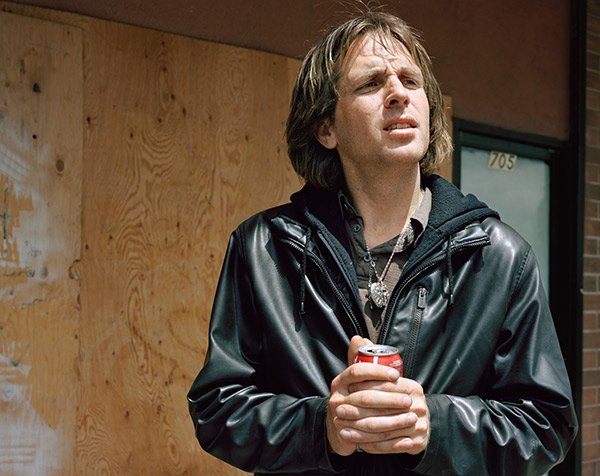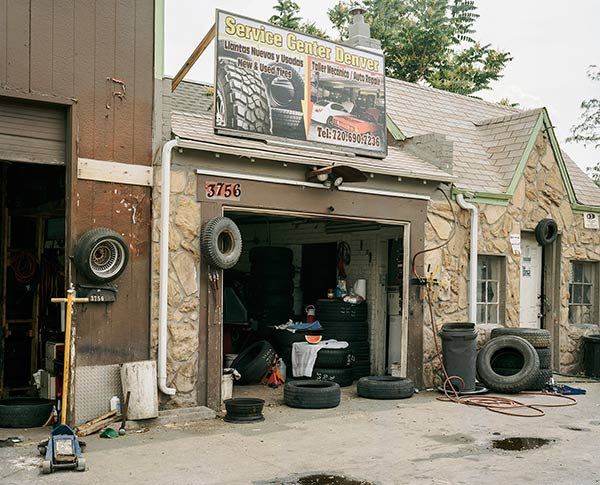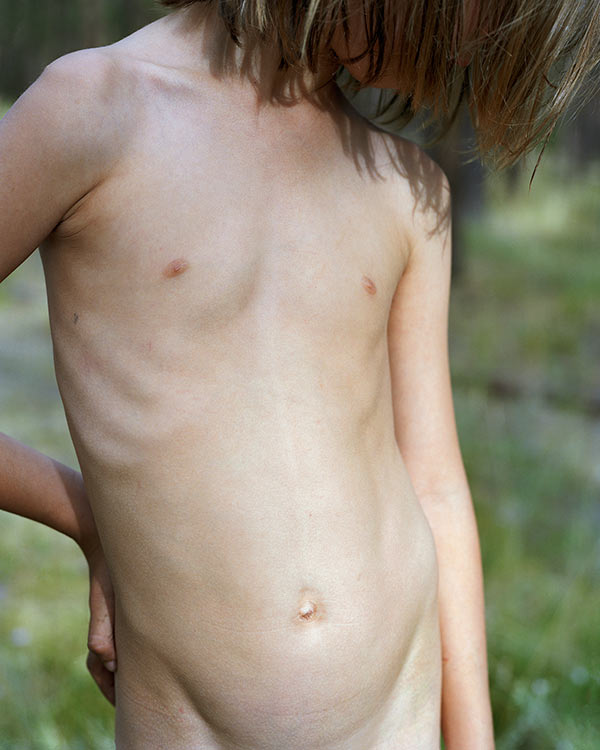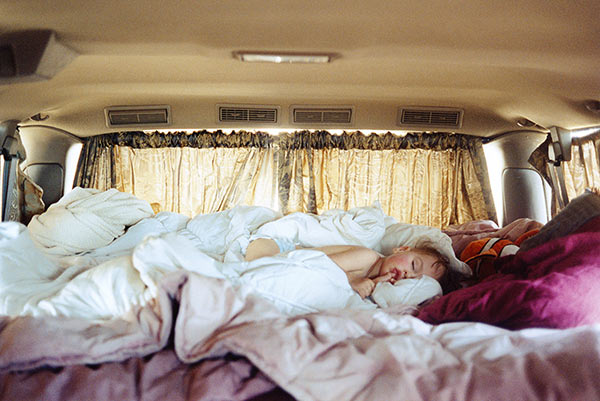Raised on the Road: Justine Kurland in Conversation with Her Son, Casper
After years traversing the U.S. in a van, the photographer and her son sit down for a candid interview.

Justine Kurland, Spit Bubble, 2013
Courtesy the artist and Mitchell-Innes & Nash
Casper McCorkle: How does this quote by William Carlos Williams reflect your road trips in your opinion?
Justine Kurland: Lynne Tillman begins her stories “Still Moving” with this quote from a poem he wrote about the wind: “I am bound more to my sentences the more that you batter me to follow you.” Highway Kind starts with photographs of trains and if you think about it, all the words in a sentence are like a train, and maybe both a sentence and a train are like the wind—they move along a path. Lynne Tillman’s stories blow against my photographs in a way that stirs up meaning.
McCorkle: I think that makes a lot of sense. I like it. In Waldo Farm Train Hoppers (2011)—where was this?
Kurland: Waldo Farm is outside Gainesville, Florida. It’s kind of like a commune—a bunch of punk, train-riding kids go and stay there for free in exchange for work. The guy who owns the place is also a photographer, but he used to be a philosophy teacher. Every night he has all the kids sit in a circle—they call it “temple”—and they read philosophers like Hegel. These kids might have dropped out of school and haven’t had a lot of education but because they’re all working together, they can understand some really deep, complex ideas.
McCorkle: Could I ask a question? You said the leader used to be a philosophy person or whatever. What philosophy does he believe in? Do you know?
Kurland: I think maybe anarchy or Marxism. When I was there they were reading Hegel, who wrote this book called Phenomenology of the Spirit (1807), which later became a model for Karl Marx. It’s about the master–slave relationship. Part of the philosophy is that everyone should live off the labors of their own work, and that mastery is achieved through labor.
Do you remember going to these different places to look for trains to photograph?

Justine Kurland, Waldo Farm Train Hoppers, 2011
Courtesy the artist and Mitchell-Innes & Nash
McCorkle: Yeah. I think I always used to—it was called a shutter, I think, right? I used to . . .
Kurland: You would press the shutter for me?
McCorkle: Yeah. I have a question about basically all of the train pictures. How long did you normally have to wait until a train came, and did you know when the trains would come by?
Kurland: Sometimes we would wait so long. Sometimes we would wait all day. We met rail fans who helped us. Do you remember those guys?
McCorkle: I remember that, yeah!
Kurland: There was one guy in Colorado who used to work for the railroad, so he knew the schedule. And there were these designated spots, the Donner Pass or the Tchepatche Loop, or the Caliente Pass, or in the San Gabriel mountains where we met other people. There was a guy in California who brought us some place in the mountains. And remember? We got chased by cows.

Justine Kurland, Union Pacific at Donner Pass, 2008
Courtesy the artist and Mitchell-Innes & Nash
McCorkle: They threw us into a bush?
Kurland: That was a different story. We were chased by dogs, and I threw you over the fence into a bush so the dogs couldn’t get to you.
McCorkle: You’re a great parent.
Kurland: When I showed my photographs to the rail fans, they weren’t impressed because they had zoom lenses and tried to photograph the trains in a particular ways. But I’d want the train to disappear into the landscape. I wanted to talk about how the train had become part of the landscape.
McCorkle: I have a question. What’s your favorite photo out of all of these that you made?
Kurland: I think the last photograph in this book is my favorite. It’s this guy. You know why I like him? His hair and his bone structure—he looks exactly like what you’re going to look like when you grow up.

Justine Kurland, What Casper Might Look Like If He Grew Up to be a Junkie in Tacoma, 2013
Courtesy the artist and Mitchell-Innes & Nash
McCorkle: Oh god, he’s so ugly!
Kurland: No, he’s super handsome, what to you mean he’s ugly?
McCorkle: He’s ugly!
Kurland: He’s super handsome, he’s a foxy dude.
McCorkle: What happened to his hair?
Kurland: It’s just a style. I think that’s my favorite picture because I like to imagine you when you grow up and you’re my age. Sometimes I think about what if you’re my age and I’m your age.

Justine Kurland, Watermelon Still Life, 2012
Courtesy the artist and Mitchell-Innes & Nash
McCorkle: If I’m like forty and you’re like one? What is he doing?
Kurland: He’s a junkie. Actually when I met him he asked me if he could put his drugs in my van for a little while.
McCorkle: And what did you say?
Kurland: I said, “No thank you.”
McCorkle: What drugs?
Kurland: I don’t know. I didn’t ask him. I’d like to think you’ll have a better life than this guy. The last part of the book gets pretty depressing.
What’s your favorite picture in the book?

Justine Kurland, Keddie Wye, 2009
Courtesy the artist and Mitchell-Innes & Nash
McCorkle: The overpass picture.
Kurland: The Keddie Wye?
McCorkle: Yeah. I remember being there and how rickety it was. I really like that the fog makes the railroad tracks the only thing you can see, and I really like the white rocks and the white wood.
Do most of the people who you photograph want to be photographed?
Kurland: I ask people to let me photograph them, and a lot of the times they say, “No.” But I never photographed anyone who didn’t want to be photographed.
McCorkle: You photographed me when I didn’t want to be photographed.
Kurland: You’re the only person I photographed who didn’t want to be photographed. But when you really didn’t want to be photographed, you just kind of walked away.

Justine Kurland, After Weston, 2010
Courtesy the artist and Mitchell-Innes & Nash
McCorkle: Okay.
Kurland: It’s true. The times I photographed you when you didn’t want me to, we would make a make deal. And a deal is a deal.
McCorkle: You know what I really like about this book? It doesn’t stick to one theme. It has a theme of cars, and trains, and me when I was little, and it’s just really cool.
Kurland: The back of this book has some of the snapshots I took between the other photographs.
McCorkle: I remember this one. Well, of course I was asleep. But I remember going in the back of the van and then waking up when you were still sound asleep and dreaming. I also remember waking up to that really awesome noise of the rain on the roof. Sometimes I was asleep and I slept for a long time and you were driving and I was still in the back.
I remember you taking so long to write this thing called “Now We Are Six” and I really like the writing of it. I think it’s really good. It really describes the road trip experience. And I think these two photos just go really well with your writing, especially the van when it’s sort of dirty.
Kurland: Do you remember this one where you’re brushing your teeth? We used to talk about you brushing your teeth professionally?

Justine Kurland, Untitled (Sleeping in Van), 2006
Courtesy the artist and Mitchell-Innes & Nash
McCorkle: Yes, and there was a spit bowl, oh god.
Kurland: We didn’t have a sink so you had to use the water out of the jug and a spit bowl.
McCorkle: In the picture with the birds, I remember being there, and it was kind of cool and really scary.
Kurland: When I showed you these pictures for the back of the book you described this photograph formally. You talked about the birds and your hair being chaotic—do you remember saying that? It was a good way to describe the photograph.
McCorkle: And also the signs. The buildings are neat and organized and then there’s basically chaos. It looks like the birds have wrecked havoc. They have destroyed the landscape. These signs look dirty and then over here it’s all nice in that direction the birds are headed in.
Kurland: What do you think overall of the book? Would you do anything different if you could?

Justine Kurland, Untitled (Birds), 2008
Courtesy the artist and Mitchell-Innes & Nash
McCorkle: No, I really like what you did with the book.
Kurland: Do you wish we were still on the road?
McCorkle: No, I like my friends and I have a good school.
Kurland: You’re glad we got off the road?
McCorkle: I think we got off the road at a good time. When elementary school started in first grade, I think that was a good time.
I wish I could teleport to some of the places we’ve gone and sleep in the van. But the one thing I didn’t like about being on the road was the six hour, eight hour trips. But yeah if I could just teleport anywhere with the van, I would definitely do that a lot. Like on the weekends, just teleport to the sand dunes, teleport to Red Rock Canyon, all the places in your photographs, and see what changed. You know what I mean?
Kurland: Yeah. It was a long time ago for some of these places.
When you look through these pictures, do you think it was a happy childhood?
McCorkle: I don’t know. Yeah, I think. Yeah.
Kurland: When you grow up and you have kids will you bring them on road trips?
McCorkle: Maybe. Probably not, I don’t know. I don’t know if I could be a photographer, but if I could, if I had all the money for gas, and they were little, I probably might. And if their mom wanted to go or whatever.






















